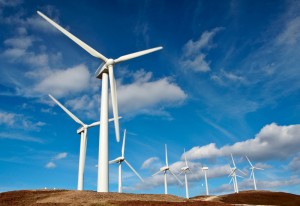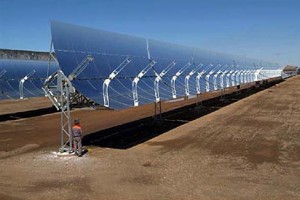Kumar Mangalam Birla-controlled Aditya Birla Nuvo Ltd will sell 49% stake in its wholly owned subsidiary Aditya Birla Renewables Ltd to a unit of international private equity firm Abraaj Group to build a renewable energy platform focused on developing solar power plants in India.
The Abraaj Group is a leading private equity investor, managing approximately $9 billion of funds and operating in the growth markets of Africa, Asia, Latin America, the Middle East, and Turkey.
Funds managed by the Abraaj Group have made over 140 investments across 10 sectors, including consumer, energy, financials, healthcare and utilities, its website said.
“As per the SSA, subject to the customary closing conditions and subject to the requisite approvals, Aditya Birla Nuvo and AEIF Mauritius SPV 1 Ltd will hold 51% and 49% of the paid up share capital respectively, in Aditya Birla Renewables,” Aditya Birla Nuvo said in the filing.
The deal comes at a time when the government is pursuing an ambitious target to generate 175,000 megawatts (MW) of green energy by 2022. Of the total 100,000 MW of solar power capacity planned, 20,000 MW will come from solar parks and 40,000 MW each from roof-top and distributed generation projects. The government plans to set up 25 such solar parks. India has around 300 days of sunshine per year.
In July, Japanese telecom and Internet company SoftBank Corp. said it will set up a 20 gigawatt (GW) solar power plant in Andhra Pradesh. SoftBank, along with Bharti Enterprises Ltd and Taiwan’s Foxconn Technology Co. Ltd, in June proposed to invest at least $20 billion in solar energy projects in India through a joint venture, SBG Cleantech.
The Gautam Adani-controlled Adani Group has also started acquiring land to set up a solar park in Tamil Nadu, tipped to be among the world’s largest, with an outlay of Rs4,536 crore.
In July, the board of Aditya Birla Nuvo had approved participation in the bidding process for upcoming central, state and private sector solar power projects.
The proposed entry into the power sector comes eight years after the group exited the power generation business when it sold two proposed 1,000 MW projects and liquidated another one soon after it had completed first-stage work, including land acquisition and environmental clearances.
India needs as much as $200 billion to meet its target of installing 100,000 MW of solar power capacity and 60,000 MW of wind power capacity by 2022.
![Aditya Birla Nuvo to sell 49% in renewables unit to Abraaj Kumar Mangalam Birla-controlled Aditya Birla Nuvo Ltd will sell 49% stake in its wholly owned subsidiary Aditya Birla Renewables Ltd to a unit of international private equity firm Abraaj Group to build a renewable energy platform focused on developing solar power plants in India. The Abraaj Group is a leading private equity investor, managing approximately […]](http://www.renewablesmart.com/wp-content/uploads/2015/10/aditya-birla-nuvo.jpg)
![Renewable Energy Opportunity in India As a part of India’s energy supply, Prime Minister Narendra Modi is focusing more on renewable energy. The focus is basically on solar projects which can be known from the 2014-15 budget declared by Finance minister Arun Jaitley. There is a plan to build 100,000 solar powered pumps and pumping stations. The plan also includes […]](http://www.renewablesmart.com/wp-content/uploads/2014/10/renewable-energy-India.jpg)
![Japan approves renewable subsidies Japan has approved incentives for renewable energy that could unleash billions of dollars in clean-energy investment and help the world’s third-biggest economy shift away from a reliance on nuclear power after the Fukushima disaster. Industry Minister Yukio Edano approved the introduction of feed-in tariffs (FIT), which means higher rates will be paid for renewable energy. […]](http://www.renewablesmart.com/wp-content/uploads/2011/08/wind_power_project-750x500.jpg)
![Indian Govt. Revised 2020 Renewable Energy Targets From 6 to 15% India’s Union Minister of New and Renewable Energy has announced the increase of the country’s 2020 renewable energy targets, from 6 to 15%. At the Institute of International and European Affairs (IIEA), held in Ireland’s capital, Dublin, Farooq Abdullah additionally said that an action plan has been developed, which lays the ground for 30 GW […]](http://www.renewablesmart.com/wp-content/uploads/2010/10/india-renewable-energy.jpg)
![REaction 2012 – Conference on renewable energy from July 26, 2012 With the cost of power generated using diesel at over Rs.50,000 crore every year for Indian industry and set to only go up, it is imperative to switch over to renewable energy sources. Seeking to convey this message, organisers of the upcoming ‘REaction 2012,’ a two-day conference on D2R (diesel to renewable), said use of […]](http://www.renewablesmart.com/wp-content/uploads/2012/06/REaction-2012.jpg)
![China to spend US$27 Bn on energy conservation and renewables China’s central government plans to spend US$27 Bn this year to promote energy conservation, emission reductions and renewable energy, the Ministry of Finance said. The ministry said China plans to promote more use of energy-saving products and low or no-emission power generation such as solar and wind. It also wants to accelerate the development of […]](http://www.renewablesmart.com/wp-content/uploads/2010/01/China-renewables.jpg)
![Suzlon Energy Signs MoU With AP Govt For 3,000mw Power Projec Suzlon Energy, has signed a MoU with the Andhra Pradesh government for setting up of capacities to generate about 3,000 mw of wind power till 2016. The proposal entails an investment of about Rs18,000 crore. Under the MoU, which was signed at the recent Partnership Summit in Hyderabad, the state government will facilitate Suzlon in […]](http://www.renewablesmart.com/wp-content/uploads/2012/01/suzlon-company-logo.jpg)

![US Approves Blythe Solar Power Project The biggest solar project that plans to provide power to more than 3,00,000 homes in southern California was permitted by the US interior department. The US$6 Bn, 1,000MW project, a joint venture of Solar Millennium AGand Ferrostaal AG, will be located on federal lands near Blythe, in the southern tip of California. “The Blythe Solar […]](http://www.renewablesmart.com/wp-content/uploads/2010/10/Solar-Millennium-Blythe-solar.jpg)

